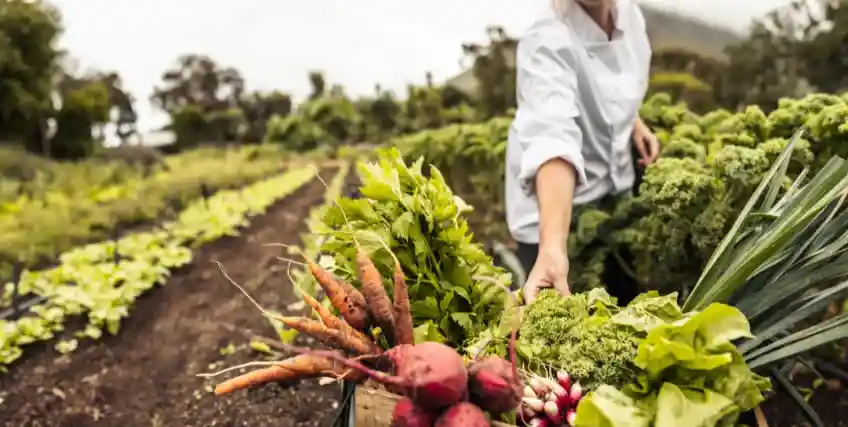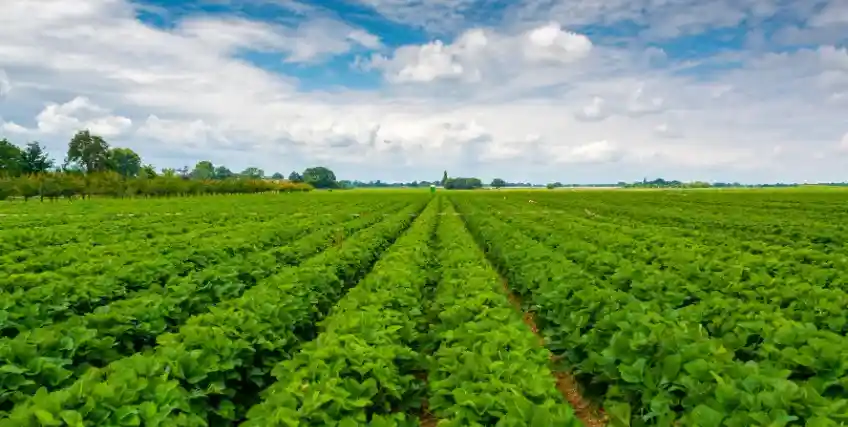Loan Options for Organic Farming: How to Secure Funding for Your Farm
Oct 14, 2025 | Last Updated on: Oct 15, 2025

The organic farming industry is growing rapidly across the United States. Many agricultural producers, ranchers, and organic farmers are turning to sustainable farming methods to meet consumer demand. However, starting or expanding an organic farming operation comes with a major challenge. This is finding the right funding option.
Organic farmers often have to deal with land, equipment, organic certification, and labor costs. Since these expenses add up quickly, farm loan options for organic farming can make the difference between staying small and building a thriving business. There are multiple loan programs offered by the U.S. Department of Agriculture (USDA), traditional banks, and other institutions. These programs support new farmers, beginning farmers, ranching operations, and experienced organic producers alike.
In this article, we'll break down loan options for organic farming, explain the loan application process, and share practical tips to secure the right organic farm loans. We'll also discuss how to work with a lender, prepare your business plan, and find the right financing structure for your farm's goal.
Importance of Financing for Organic Farmers
For organic producers, loan options for organic farming are more than just a way to cover bills. It's often the foundation for sustainable growth. Unlike conventional agriculture, organic farming requires upfront investment in soil health, infrastructure, and compliance. It also includes costs related to land improvement, irrigation, labor, organic certification, and ongoing documentation.
Here's how funding for organic farm projects can be used:
- Land and Real Estate: Funds from different loan options for organic farming can be used for buying or leasing farmland.
- Infrastructure: Organic producers can use business loans for investing in greenhouses, barns, and storage units that are essential for specialty crops and value-added products.
- Farm Operating Costs: Operating costs like seeds, inputs, and labor can be funded with the help of loan options for organic farming before revenue arrives.
- Certification Cost: Achieving USDA organic certification can involve inspection fees and annual renewals which can be funded with financing options for organic farming.
- Risk Management: Having necessary funds also helps business owners navigate pests, market swings, or drought.
Quick Insight: According to the Organic Trade Association, the U.S. organic sales reached a new high of $71.6 billion in 2024. The annual growth rate was 5.2%, more than double that of the overall marketplace. So, it shows that as demand climbs, farms that secure stable financing are positioned to meet the market confidently.
Understanding Loan Options for Organic Farming
Different organic farm owners have different types of business needs. Fortunately, there are a wide range of loan options for organic farming such as agricultural loans, dairy loan programs, organic farm loans, and others. These funding options are designed to support organic farming and ranching operations.
Some of the common loan options for organic farming include:
1. USDA Loans and FSA Loans
The Farm Service Agency, which is a part of the USDA, offers a wide range of farm loans for agricultural producers. This includes both beginning farmers and existing farmers and ranchers. These loan options for organic farming are typically backed by the farm bill, which makes them more flexible and affordable.
Additionally, these loan programs offer lower interest rates, longer repayment terms, and come with reduced down payment requirements.
Some of the popular FSA loan programs include:
- Farm Ownership Loans: These loans are ideal for purchasing land or expanding acreage.
- Operating Loans: Business owners can use these loans for operating expenses, equipment, seed, and labor.
- Microloans: These are suitable for organic farming businesses that need smaller amounts to get started.
- Farm Storage Facility Loans: These loans support infrastructure like silos, cold storage, or renewable energy installations.
2. SBA Loans
SBA loans are backed by the U.S. Small Business Administration and are ideal for small business owners. Since these loans aren't specific to farming, many agribusinesses and organic producers use them. Organic farming owners can use SBA loans such as SBA 7(a) and SBA 504 for funding marketing expansions, purchasing equipment, or real estate development. Also, these loans come with lower interest rates and longer repayment terms for qualified applicants, which can help stabilize cash flow.
3. Term Loans
Term loans are offered by traditional banks, credit unions, and Farm Credit institutions, among others. They offer a lump sum loan amount upfront that can be repaid over a set period of time. Business owners can use term loan options for organic farming for large purchases or farm expansion. Moreover, these can be used for growing specialty crops or installing new irrigation systems. However, term loans require strong financial statements, collateral, and a solid business plan.
4. Equipment Financing
Equipment financing is another funding method that is used to purchase business assets. These can include the necessary tools, machinery, and technology. Instead of paying upfront for the equipment, business owners can pay in easy monthly installments using equipment loans. Moreover, the equipment itself acts as collateral, which reduces the risk for both lenders and borrowers.
5. Business Lines of Credit
A business line of credit is a flexible funding option that can be used by business owners when they need quick access to funds. They come up with a pre-approved credit limit where business owners can draw funds as they need them and pay interest only on the amount used. A line of credit can also be used as an organic farming loan option to support healthy cash flow during the growing season.
How Organic Farmers Can Apply For Funding
Business owners can use different loan options for organic farming projects but they do require preparation. So, here are a few tops to secure funding for organic farms.
Step 1: Clarify Your Needs
Identify your priorities such as real estate, equipment, operating capital, or certification costs. A clear vision helps match you with the right loan program.
Step 2: Build a Business Plan
A well-structured business plan gives lenders confidence when you apply for loan options for organic farming. Include:
- Production goals and acreage
- Market strategies for specialty crops and value-added products
- Financial projections and repayment timelines
- Risk management strategies, including crop insurance
Step 3: Gather Documentation
Lenders and agencies such as the FSA require financial records, tax returns, land deeds, organic certification, and sometimes stewardship plans through the Natural Resources Conservation Service (NRCS).
Step 4: Explore Cost Share Programs
The USDA's Cost Share Program reimburses up to 75% of certification costs (up to $750 per scope). This lowers your overall loan requirement.
Step 5: Apply Strategically
Work with a loan officer to navigate the application process. Submit to multiple lenders including FSA, commercial lenders, and nonprofit financing partners to find the best interest rates and terms.
What Lenders Look For
Understanding what lenders evaluate can give your loan application a competitive edge. Here's what lenders look for when you apply for loan options for organic farming:
- Creditworthiness: Timely payments and low debt improve your score.
- Collateral: Land, equipment, or buildings strengthen your file.
- Business Plan: Clear goals and projections signal reliability.
- Experience: Seasoned agricultural producers and certified organic producers stand out.
- Stewardship: Strong soil health and renewable energy initiatives can appeal to lenders focused on sustainability.
The Bottom Line: The stronger your application, the better your chances of securing organic farm loans with favorable terms.
Tips to Improve Loan Approval Chances
Boosting approval odds when you apply for loan options for organic farming is often about preparation:
- Strengthen Credit: Pay off debts, avoid late payments, and review your report before applying.
- Start Small: New farmers might begin with microloans to build borrowing history.
- Leverage Programs: Tap into cost share programs, risk management tools, and rural development initiatives.
- Work with Advisors: Local USDA offices, loan officers, and nonprofit organizations can guide you.
- Document Stewardship: Show how you manage land through NRCS programs.
- Highlight Value-Added Opportunities: Lenders often support operations that enhance local markets and diversify income.
The Final Word
Building a successful organic farm requires more than passion. It requires access to loan options for organic farming, smart planning, and partnerships with the right lender. There are numerous loan programs that exist to make capital more accessible for beginning farmers, ranchers, and seasoned operators.
By preparing a strong business plan, understanding the application process, and exploring all loan programs, you can secure funding for organic farm projects that fuel growth. The organic market continues to expand, and now is the time to position your farm to meet that demand.
So, start today by listing your funding needs. You can also reach out to your local Farm Service Agency office, connect with a loan officer, and explore programs on farmers.gov. With the right financial tools, your farm can thrive for years to come.
FAQs About Loan Options for Organic Farming
1. Can new farmers qualify for USDA or FSA loan programs?
Beginning farmers and new ranchers can qualify for several USDA and FSA loan programs. The U.S. Department of Agriculture offers operating loans, farm ownership loans, and microloans with reduced down payment requirements. These loan options for organic farming are designed to support agricultural producers who may not yet meet traditional commercial lender standards.
2. What expenses can farm loans cover for organic producers?
Farm loans can cover a wide range of expenses for organic producers. Common uses include buying real estate, covering operating costs, funding organic certification, or paying certification cost fees. Loans may also support equipment purchases, renewable energy projects, or storage through a Farm Storage Facility Loan.
3. How do lenders evaluate a loan application for organic farming?
Lenders look for several key factors during the loan application process. They evaluate your business plan, cash flow projections, and the viability of your agricultural production. Many lenders also consider your stewardship practices, crop insurance coverage, and risk management strategies, especially organic farming and ranching.
4. Are there any programs that help reduce the cost of organic certification?
Several programs help organic producers offset certification costs. The USDA's Cost Share Program reimburses a portion of certification expenses for organic farmers and ranchers. These initiatives support rural development and encourage more agricultural producers to adopt organic practices.
5. What is the difference between USDA guaranteed loans and direct loans?
USDA guaranteed loans are issued by commercial lenders but backed by the U.S. Department of Agriculture, reducing lender risk. Direct loans, on the other hand, come directly from the Farm Service Agency (FSA). Guaranteed loans often suit larger agribusinesses and experienced organic producers, while direct loans are ideal for beginning farmers or those with limited credit history.
Frequent searches leading to this page
Term Loans are made by Itria Ventures LLC or Cross River Bank, Member FDIC. This is not a deposit product. California residents: Itria Ventures LLC is licensed by the Department of Financial Protection and Innovation. Loans are made or arranged pursuant to California Financing Law License # 60DBO-35839




